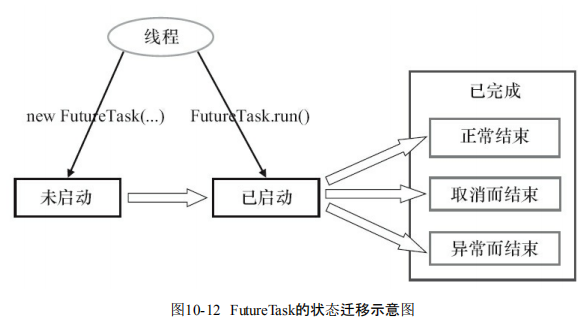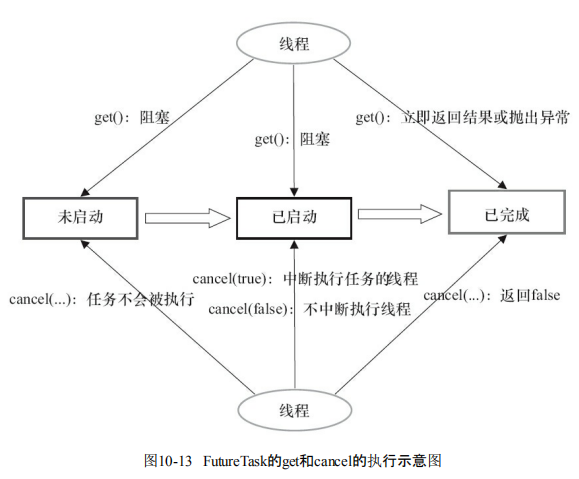Java并发编程的艺术笔记(九)——FutureTask详解
FutureTask是一种可以取消的异步的计算任务。它的计算是通过Callable实现的,多用于耗时的计算。
一.FutureTask的三种状态

二.get()和cancel()执行示意

三.使用
一般FutureTask多用于耗时的计算,主线程可以在完成自己的任务后,再去获取结果。
3.1 FutureTask + Thread
package concurrent; import java.util.Random; import java.util.concurrent.Callable; import java.util.concurrent.ExecutionException; import java.util.concurrent.FutureTask; /** * * @author Administrator * */ @SuppressWarnings("all") public class FutureTaskDemo { public static void main(String[] args) { //step2:创建计算任务,作为参数,传入FutureTask CalculateTask cTask = new CalculateTask(); FutureTask futureTask = new FutureTask(cTask); //step3:将FutureTask提交给Thread执行 Thread pAccountThread = new Thread(futureTask); System.out.println("futureTask线程现在开始启动,启动时间为:" + System.nanoTime()); pAccountThread.start(); System.out.println("主线程开始执行其他任务"); // 从其他账户获取总金额 int totalMoney = new Random().nextInt(100000); System.out.println("现在你在其他账户中的总金额为" + totalMoney); System.out.println("等待私有账户总金额统计完毕..."); // step4:测试后台的计算线程是否完成,如果未完成则等待 while (!futureTask.isDone()) { try { Thread.sleep(500); System.out.println("私有账户计算未完成继续等待..."); } catch (InterruptedException e) { e.printStackTrace(); } } System.out.println("futureTask线程计算完毕,此时时间为" + System.nanoTime()); Integer privateAccountMoney = null; //step5:获取执行结果 try { privateAccountMoney = (Integer) futureTask.get(); } catch (InterruptedException e) { e.printStackTrace(); } catch (ExecutionException e) { e.printStackTrace(); } System.out.println("您现在的总金额为:" + totalMoney + privateAccountMoney.intValue()); } } /** * @author admin *step1:封装一个计算任务,计算私有账户余额,实现Callable接口 */ @SuppressWarnings("all") class CalculateTask implements Callable { Integer totalMoney; @Override public Object call() throws Exception { //模拟耗时操作 Thread.sleep(5000); totalMoney = new Integer(new Random().nextInt(10000)); System.out.println("您当前有" + totalMoney + "在您的私有账户中"); return totalMoney; } }
执行结果:
futureTask线程现在开始启动,启动时间为:57541141963086 主线程开始执行其他任务 现在你在其他账户中的总金额为30431 等待私有账户总金额统计完毕... 私有账户计算未完成继续等待... 私有账户计算未完成继续等待... 私有账户计算未完成继续等待... 私有账户计算未完成继续等待... 私有账户计算未完成继续等待... 私有账户计算未完成继续等待... 私有账户计算未完成继续等待... 私有账户计算未完成继续等待... 私有账户计算未完成继续等待... 您当前有4831在您的私有账户中 私有账户计算未完成继续等待... futureTask线程计算完毕,此时时间为57546161371100 您现在的总金额为:304314831
3.2 Future + ExecutorService
//step1 ...... //step2:创建计算任务 Task task = new Task(); //step3:创建线程池,将Callable类型的task提交给线程池执行,通过Future获取子任务的执行结果 ExecutorService executorService = Executors.newCachedThreadPool(); final Future<Boolean> future = executorService.submit(task); //step4:通过future获取执行结果 boolean result = (boolean) future.get();
四.源码解析
4.1 状态
private volatile int state; private static final int NEW = 0; private static final int COMPLETING = 1; private static final int NORMAL = 2; private static final int EXCEPTIONAL = 3; private static final int CANCELLED = 4; private static final int INTERRUPTING = 5; private static final int INTERRUPTED = 6;
4.2 构造函数
/** * Creates a {@code FutureTask} that will, upon running, execute the * given {@code Callable}. * * @param callable the callable task * @throws NullPointerException if the callable is null */ public FutureTask(Callable<V> callable) { if (callable == null) throw new NullPointerException(); this.callable = callable; this.state = NEW; // ensure visibility of callable }
可以看到FutrueTask传入的是一个Callable类型的变量,将传入的参数赋值给this.callable,然后设置state状态为NEW,表示这是新任务。
也可以使用Runnable+result组合成一个Callable
public static <T> Callable<T> callable(Runnable task, T result) { if (task == null) throw new NullPointerException(); return new RunnableAdapter<T>(task, result); }
4.3执行任务——run()方法
public void run() { //1.判断状态是否是NEW,不是NEW,说明任务已经被其他线程执行,甚至执行结束,或者被取消了,直接返回 //2.调用CAS方法,判断runnerOffset为null的话,就将当前线程保存到runnerOffset中 //设置runnerOffset失败,就直接返回 if (state != NEW || !UNSAFE.compareAndSwapObject(this, runnerOffset, null, Thread.currentThread())) return; try { //执行callable任务,返回result Callable<V> c = callable; if (c != null && state == NEW) { V result; boolean ran; try { result = c.call(); ran = true; } catch (Throwable ex) { result = null; ran = false; //遇到异常,设置异常 setException(ex); } //执行完毕,设置result if (ran) set(result); } } finally { // runner must be non-null until state is settled to // prevent concurrent calls to run() //设置runner为null runner = null; // state must be re-read after nulling runner to prevent // leaked interrupts int s = state; //如果被中断了,处理中断 if (s >= INTERRUPTING) handlePossibleCancellationInterrupt(s); } }
看一下runnerOffset是啥:
private static final sun.misc.Unsafe UNSAFE;private static final long runnerOffset; static { try { UNSAFE = sun.misc.Unsafe.getUnsafe(); Class<?> k = FutureTask.class;
runnerOffset = UNSAFE.objectFieldOffset (k.getDeclaredField("runner")); } catch (Exception e) { throw new Error(e); } }
可以看到它指向runner字段的偏移地址,相当于指针
发生异常:
protected void setException(Throwable t) {
// stateOffset NEW --> COMPLETING if (UNSAFE.compareAndSwapInt(this, stateOffset, NEW, COMPLETING)) {
//返回异常信息 outcome = t;
//stateOffset --> EXCEPTIONAL UNSAFE.putOrderedInt(this, stateOffset, EXCEPTIONAL); // final state
//结束 finishCompletion(); } }
正常执行:
protected void set(V v) { //state New --> COMPLETING if (UNSAFE.compareAndSwapInt(this, stateOffset, NEW, COMPLETING)) { //返回结果 outcome = v; //state --> NORMAL UNSAFE.putOrderedInt(this, stateOffset, NORMAL); // final state //结束 finishCompletion(); } }
被中断:
private void handlePossibleCancellationInterrupt(int s) { // It is possible for our interrupter to stall before getting a // chance to interrupt us. Let's spin-wait patiently. if (s == INTERRUPTING) while (state == INTERRUPTING) //让出线程 Thread.yield(); }
4.4 获取结果——get()方法
public V get() throws InterruptedException, ExecutionException { //获取状态 int s = state; //如果没有完成则等待 if (s <= COMPLETING) s = awaitDone(false, 0L); return report(s); }
进去看一下awaitDone()方法
private int awaitDone(boolean timed, long nanos) throws InterruptedException { final long deadline = timed ? System.nanoTime() + nanos : 0L; WaitNode q = null; boolean queued = false; for (;;) { //如果被中断,则移除wait节点,并返回异常 if (Thread.interrupted()) { removeWaiter(q); throw new InterruptedException(); } //1 得到状态 int s = state; //1.1 如果s > COMPLETING,直接返回 if (s > COMPLETING) { if (q != null) q.thread = null; return s; } //1.2 如果s == COMPLETING但是还没写到outcome,表示任务结束,让出线程 else if (s == COMPLETING) // cannot time out yet Thread.yield(); //q == null,则 new 一个新的节点 else if (q == null) q = new WaitNode(); //如果还没有加入等待队列,则加入队列头 else if (!queued) queued = UNSAFE.compareAndSwapObject(this, waitersOffset, q.next = waiters, q); //如果设置了超时时间 else if (timed) { nanos = deadline - System.nanoTime(); //时间到了移除节点,停止等待 if (nanos <= 0L) { removeWaiter(q); return state; } //时间没到,阻塞,等待 LockSupport.parkNanos(this, nanos); } //没设置则阻塞,等待 else LockSupport.park(this); } }
4.5 cancel()方法
public boolean cancel(boolean mayInterruptIfRunning) { //state != NEW,返回false //state == NEW,判断是否要中断任务的执行,是则stateOffset=INTERRUPTING,否则stateOffset=CANCELLED if (!(state == NEW && UNSAFE.compareAndSwapInt(this, stateOffset, NEW, mayInterruptIfRunning ? INTERRUPTING : CANCELLED))) return false; try { // in case call to interrupt throws exception if (mayInterruptIfRunning) { try { Thread t = runner; //读取当前正在执行子任务的线程runner,调用t.interrupt(),中断线程执行 if (t != null) t.interrupt(); } finally { // final state //stateOffset = INTERRUPTED UNSAFE.putOrderedInt(this, stateOffset, INTERRUPTED); } } } finally { finishCompletion(); } return true; }
4.6 最终方法finishCompletion(),释放资源
private void finishCompletion() { // assert state > COMPLETING; for (WaitNode q; (q = waiters) != null;) { if (UNSAFE.compareAndSwapObject(this, waitersOffset, q, null)) { for (;;) { Thread t = q.thread; if (t != null) { q.thread = null; LockSupport.unpark(t); } WaitNode next = q.next; if (next == null) break; q.next = null; // unlink to help gc q = next; } break; } } done(); callable = null; // to reduce footprint }





 浙公网安备 33010602011771号
浙公网安备 33010602011771号